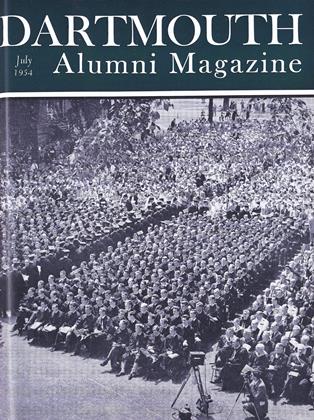LesterM. Nichols '40. New York: Bradbury, Sayles,O'Neill, 1954. 356 pp. $7-50.
There has been tremendous progress during the past decade or so in the technique of writing military history. This is owing in part to the fact that the historians of World War II are in many instances veterans of the conflict and thus familiar with the war at first hand. In any case, they have had access not only to voluminous documentary sources, but also to information supplied by those who actually did the fighting. Another trend is evident in the emphasis which is being given to the study of operations at the lower military levels, thus avoiding exclusive concentration upon considerations of over-all strategy at the higher echelons of command.
Impact: the Battle Story of the TenthArmored Division, by Lester M. Nichols, 40, reflects both of these trends. Major Nichols was press officer of the unit in question during its period of combat service, which has given him access to a vast amount of official documentary material. But the study of documents has been supplemented by personal interviews with a large number of surviving men and officers of the Division. As a result, Major Nichols' account comes very close to the basic realities of warfare as revealed in the day-by-day operations of a combat unit.
The Tenth Armored Division, frequently referred to as "the Tigers," landed at Cherbourg in September, 1944, and during the next few months was engaged almost continuously in the offensive operations involved in the penetration of the Siegfried Line and the actual invasion of Germany. Its long smashing drive carried it by the end of the war through southern Germany to the vicinity of the Brenner Pass. The Tenth Armored Division appears to have served in the role of "trouble-shooter," and the Germans nicknamed it the "ghost division" due to its frequent and unexpected appearances in critical sectors. Major Nichols gives a vivid and fascinating account of the slamming, slashing tactics characteristic of tank units in modern war. For most readers the high point of the narrative will be the chapters dealing with the epic defense of Bastogne during the Battle of the Bulge in the winter of 1944-1945.
The many illustrations and battle maps and diagrams are an outstanding feature of the volume and contribute greatly to the value and interest of the narrative. There are many personal details and incidents which will appeal more to veterans of the Division than to the average reader, but as a description of the stark realities of war at the tactical level, seen through the operations of an outstanding combat unit, Major Nichols account can be warmly recommended. It is a notable contribution to the ever-growing literature of World War II.
 View Full Issue
View Full Issue
More From This Issue
-
 Feature
FeaturePresident Emeritus Hopkins Is Honored With Dartmouth's First Alumni Award
July 1954 -
 Feature
FeatureRobert S. Oelman '31 Heads Alumni Council for 1954-55
July 1954 -
 Feature
FeatureE. S. French Retires as Life Trustee; Ruml Succeeds Him
July 1954 -
 Feature
FeatureAnother Record for the Fund
July 1954 -
 Class Notes
Class Notes1929's Record-Breaking 25th
July 1954 By CHRISTIAN E. BORN '29, BILL ANDRES, SQUEEK. -
 Article
ArticleThe 1954 Commencement
July 1954 By FRANK PEMBERTON
WAYNE E. STEVENS
-
 Lettter from the Editor
Lettter from the EditorDartmouth Manuscript Series—The First Volume
MARCH 1932 -
 Books
BooksNEW YORK IN THE CRITICAL PERIOD,
March 1934 By Wayne E. Stevens -
 Books
BooksTHE COMMAND OF THE HOWE BROTHERS DURING THE AMERICAN REVOLUTION
June 1936 By Wayne E. Stevens -
 Books
BooksEMPIRE OR INDEPENDENCE: A STUDY IN THE FAILURE OF RECONCILIATION, 1774-1783
October 1941 By Wayne E. Stevens -
 Books
BooksFLIGHT IN WINTER,
April 1942 By Wayne E. Stevens -
 Books
BooksSEAT OF EMPIRE: THE POLITICAL ROLE OF EIGHTEENTH-CENTURY WILLIAMSBURG
February 1951 By Wayne E. Stevens
Books
-
 Books
BooksALUMNI PUBLICATIONS
May 1920 -
 Books
BooksEDITOR’S PICKS
JAnuAry | FebruAry -
 Books
BooksSATIRES AND PERSONAL WRITINGS
MAY 1932 By H. M. Dargan -
 Books
Books"Composition and Literature"
July 1918 By Kenneth Allan Robinson. -
 Books
BooksA PHILOSOPHER LOOKS AT SCIENCE.
MAY 1959 By R.W. CHRISTY -
 Books
BooksTraining in Citizenship
APRIL, 1927 By Robert E. Riegel

